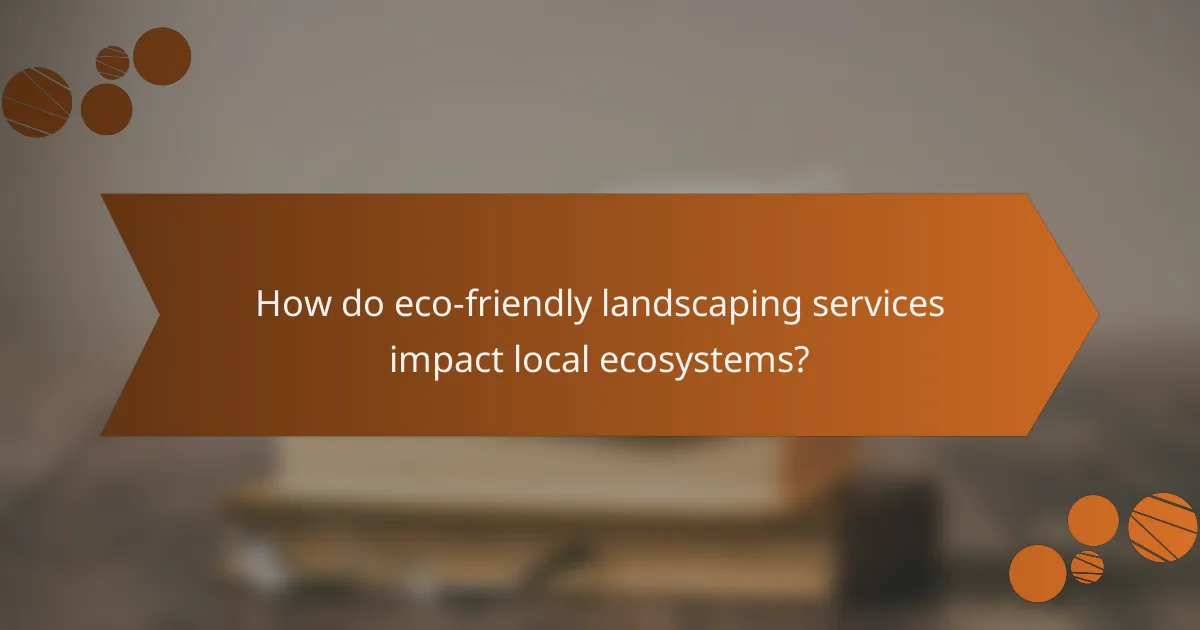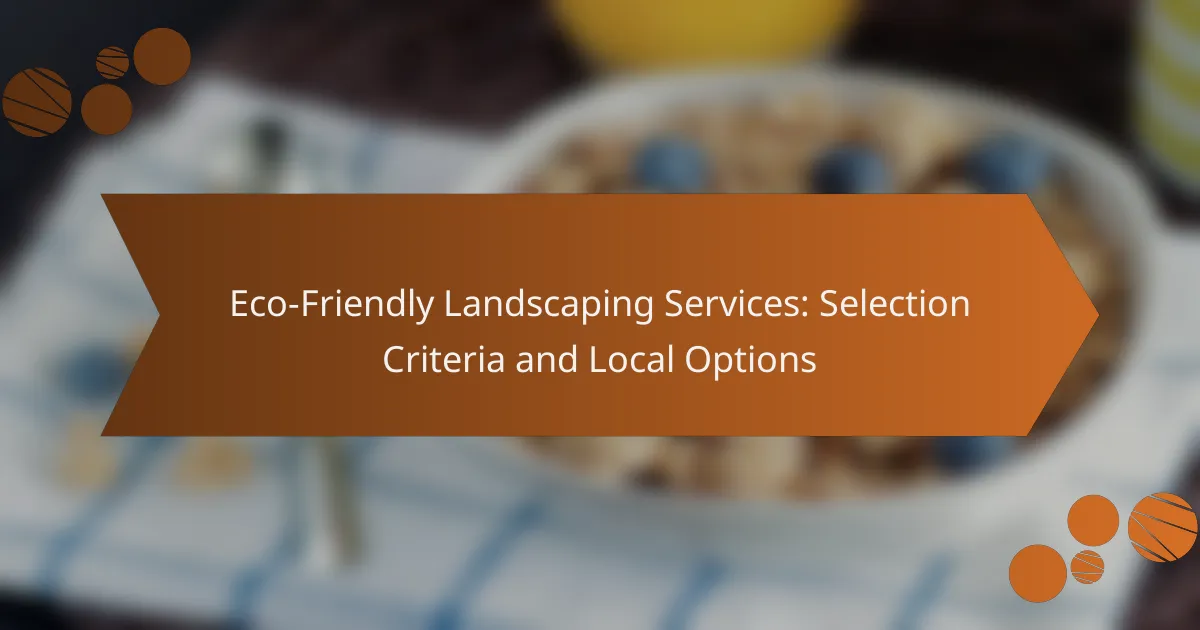In Los Angeles, eco-friendly landscaping services are designed to promote sustainability and enhance environmental health through practices such as native plant landscaping and organic lawn care. When choosing a service, it’s important to assess their offerings, certifications, and customer feedback to ensure they align with your sustainability goals. By opting for these services, homeowners can create beautiful outdoor spaces that not only look great but also support local ecosystems and reduce their carbon footprint.

What eco-friendly landscaping services are available in Los Angeles?
Los Angeles offers a variety of eco-friendly landscaping services that focus on sustainability and environmental health. These services include native plant landscaping, rain garden installation, organic lawn care, permeable paving solutions, and compost and mulch services, each designed to enhance both aesthetics and ecological balance.
Native plant landscaping
Native plant landscaping involves using plants that are indigenous to the Los Angeles region, which require less water and maintenance. This approach supports local wildlife and reduces the need for chemical fertilizers and pesticides.
When selecting native plants, consider factors such as soil type, sunlight, and water availability. Popular choices include California poppies and manzanitas, which thrive in local conditions and contribute to biodiversity.
Rain garden installation
Rain gardens are designed to capture and absorb rainwater runoff, helping to reduce flooding and improve water quality. They typically feature native plants that can tolerate both wet and dry conditions, making them ideal for the Los Angeles climate.
To install a rain garden, choose a location that collects runoff, dig a shallow depression, and amend the soil with organic matter. This can be a cost-effective way to manage stormwater while enhancing your landscape.
Organic lawn care
Organic lawn care focuses on maintaining a healthy lawn without synthetic chemicals. This method uses natural fertilizers, pest control, and soil amendments to promote growth and resilience.
Key practices include aeration, overseeding with organic seeds, and applying compost. This approach not only benefits your lawn but also protects local waterways from chemical runoff.
Permeable paving solutions
Permeable paving solutions allow water to pass through surfaces, reducing runoff and promoting groundwater recharge. Options include permeable concrete, pavers, and gravel, which can be used for driveways, patios, and walkways.
When considering permeable paving, ensure proper installation to maintain functionality. This can help mitigate flooding and is often a requirement in eco-friendly landscaping projects in Los Angeles.
Compost and mulch services
Compost and mulch services provide organic material that enriches soil and retains moisture. Composting kitchen and yard waste creates nutrient-rich soil amendments, while mulch helps suppress weeds and regulate soil temperature.
Using local compost and mulch can enhance your garden’s health and reduce the need for chemical fertilizers. Many landscaping companies in Los Angeles offer these services, making it easy to incorporate them into your eco-friendly landscape.

How to choose the right eco-friendly landscaping service?
Selecting the right eco-friendly landscaping service involves evaluating their offerings, certifications, customer feedback, and pricing. Prioritize companies that align with your sustainability goals while providing quality services tailored to your needs.
Evaluate service offerings
Consider whether they offer customized solutions that fit your specific landscape needs. A good service should be able to create a tailored plan that enhances your outdoor space while minimizing environmental impact.
Check for local certifications
Local certifications can indicate a landscaping service’s commitment to eco-friendly practices. Look for certifications from recognized organizations, such as the Sustainable Sites Initiative or local environmental agencies. These certifications often require adherence to specific guidelines that promote sustainability.
Additionally, inquire about any training or educational programs the staff has completed related to sustainable landscaping. This can provide insight into their expertise and dedication to environmentally responsible practices.
Assess customer reviews
Customer reviews can provide valuable insights into the quality and reliability of an eco-friendly landscaping service. Check online platforms like Yelp, Google Reviews, or local community forums to gauge customer satisfaction and service consistency.
Pay attention to comments regarding the effectiveness of their eco-friendly practices, responsiveness, and overall project outcomes. A service with a strong track record of positive reviews is more likely to meet your expectations.
Compare pricing structures
Pricing for eco-friendly landscaping services can vary widely based on the scope of work and materials used. Obtain quotes from multiple companies to understand the average costs in your area. Be wary of prices that seem too low, as they may indicate a lack of quality or sustainable practices.
Consider the long-term savings associated with eco-friendly options, such as reduced water usage and lower maintenance costs. Investing in quality services may lead to better outcomes and savings over time.

What are the benefits of eco-friendly landscaping?
Eco-friendly landscaping offers numerous advantages, including promoting environmental health, conserving resources, and enhancing the aesthetic appeal of properties. By using sustainable practices, homeowners can create beautiful outdoor spaces that support local ecosystems and reduce their carbon footprint.
Improved biodiversity
Eco-friendly landscaping enhances biodiversity by incorporating native plants that support local wildlife, such as birds, insects, and beneficial microorganisms. These plants are better adapted to the local climate and soil conditions, requiring less maintenance and fewer resources.
To promote biodiversity, consider creating habitats like butterfly gardens or pollinator-friendly spaces. This not only attracts diverse species but also contributes to a healthier ecosystem overall.
Reduced water usage
Implementing eco-friendly landscaping techniques can significantly reduce water consumption. Native plants typically require less irrigation, as they are adapted to local rainfall patterns. Additionally, incorporating features like rain gardens or permeable paving can help manage stormwater effectively.
Using mulch and xeriscaping techniques can further minimize water needs. Homeowners can save on water bills while contributing to sustainable water management practices in their communities.
Enhanced property value
Properties with eco-friendly landscaping often see an increase in value due to their attractive, sustainable features. Buyers are increasingly looking for homes that offer environmentally conscious designs, which can make such properties more appealing in the real estate market.
Investing in native plants, efficient irrigation systems, and sustainable materials can yield a return on investment that aligns with current market trends. This not only benefits the environment but also enhances the overall marketability of the property.
Lower maintenance costs
Eco-friendly landscaping can lead to lower maintenance costs over time. Native plants generally require less care, reducing the need for fertilizers, pesticides, and frequent watering. This can save homeowners both time and money in the long run.
Additionally, implementing sustainable practices, such as composting and mulching, can improve soil health and reduce the need for costly chemical treatments. By focusing on low-maintenance solutions, homeowners can enjoy their outdoor spaces without the burden of high upkeep expenses.

What permits are required for eco-friendly landscaping in California?
In California, eco-friendly landscaping often requires various permits to ensure compliance with local regulations and environmental standards. Key permits include landscape design permits, water conservation permits, and environmental impact assessments, each serving a specific purpose in the landscaping process.
Landscape design permits
Landscape design permits are typically required for significant alterations to outdoor spaces, especially in urban areas. These permits ensure that the design adheres to local zoning laws and aesthetic guidelines. Homeowners should consult their local planning department to understand specific requirements and application processes.
In many cases, a landscape architect may be needed to create a design that meets regulatory standards. This can involve submitting detailed plans that outline plant selections, hardscaping materials, and overall layout.
Water conservation permits
Water conservation permits are essential for projects that implement significant changes to irrigation systems or water usage. California has strict regulations aimed at reducing water consumption, especially in drought-prone areas. These permits often require a detailed water management plan that outlines how the landscaping will utilize water efficiently.
Homeowners should consider using drought-resistant plants and efficient irrigation technologies, such as drip systems, to enhance their chances of permit approval. Consulting with local water agencies can provide valuable insights into best practices and requirements.
Environmental impact assessments
Environmental impact assessments (EIAs) are necessary for landscaping projects that may affect local ecosystems or wildlife. These assessments evaluate potential environmental consequences and propose mitigation strategies. In California, an EIA is often mandated for larger projects or those in sensitive areas, such as near wetlands or protected habitats.
To prepare for an EIA, homeowners should gather data on the existing environment and consult with environmental professionals. This proactive approach can help identify potential issues early and streamline the permitting process.

How do eco-friendly landscaping services impact local ecosystems?
Eco-friendly landscaping services positively influence local ecosystems by promoting biodiversity, enhancing soil health, and conserving water. These practices help create sustainable environments that support native plants and wildlife while reducing the use of harmful chemicals.
Support for local wildlife
Eco-friendly landscaping practices, such as planting native species and creating natural habitats, significantly support local wildlife. Native plants provide food and shelter for birds, insects, and other animals, fostering a balanced ecosystem. For example, incorporating flowering plants can attract pollinators like bees and butterflies, which are essential for plant reproduction.
To maximize wildlife support, consider creating diverse plantings that include a variety of heights and types. This diversity not only attracts different species but also helps maintain ecological balance. Avoid using pesticides and herbicides, as these can harm beneficial insects and disrupt local food chains.
Soil health improvement
Improving soil health is a key component of eco-friendly landscaping services. Healthy soil supports robust plant growth, retains moisture, and reduces erosion. Techniques such as composting, mulching, and using cover crops can enhance soil structure and nutrient content, leading to more resilient landscapes.
Consider implementing practices like crop rotation and organic fertilizers to further boost soil vitality. Regular soil testing can help identify deficiencies and guide amendments, ensuring that the soil remains fertile and productive. Avoiding heavy machinery can also prevent soil compaction, which negatively affects root development and water infiltration.
